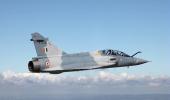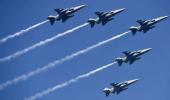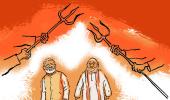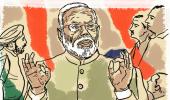'I will need a few more pictures, sir, can I get some time from you for a more extended photo shoot?' asked Singh.
Modi, ever-obliging before the camera, laughed. 'Sure, but let us plan to do it after my swearing-in is over in May!'
The Balakot effect was evident.
A fascinating excerpt from Rajdeep Sardesai's 2019: How Modi Won India.
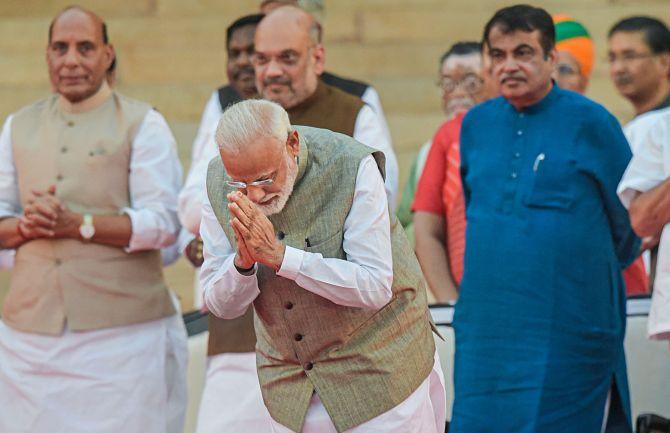
Narendra Modi arrived in the national capital well past 7 pm on 14 February. It had been a long day which had begun early morning with a trip to the forests of Uttarakhand for the Discovery Channel shoot.
The Pulwama attack meant the prime minister could scarcely afford to even think of his jungle adventure. A crisis meeting was already on at the national security secretariat, with Ajit Doval taking charge of the rapidly developing situation.
With the general election announcement less than a month away, time was not on the side of the government. The 2016 surgical strikes had set the template: Team Modi realised it couldn't afford to sit back and wait for the situation to unravel.
The first step was to ensure that the government, and not the Opposition, controlled the narrative. Before the 'intelligence failure' chorus could gather any momentum, the spirit of martyrdom was invoked.
When the bodies of the 40 slain CRPF jawans reached Palam air force area the next evening, the prime minister was there to pay homage. With a thick black shawl wrapped around his shoulders, hands folded and head bowed, Modi walked slowly around each of the 40 coffins draped in the tricolour.
In a time of national mourning, any talk of 'intelligence failure' seemed jarring.
The prime minister also directed all his ministers and BJP MPs to attend the funerals of the jawans who had belonged to their respective states. Funeral processions were organised through the towns and villages of the martyrs.
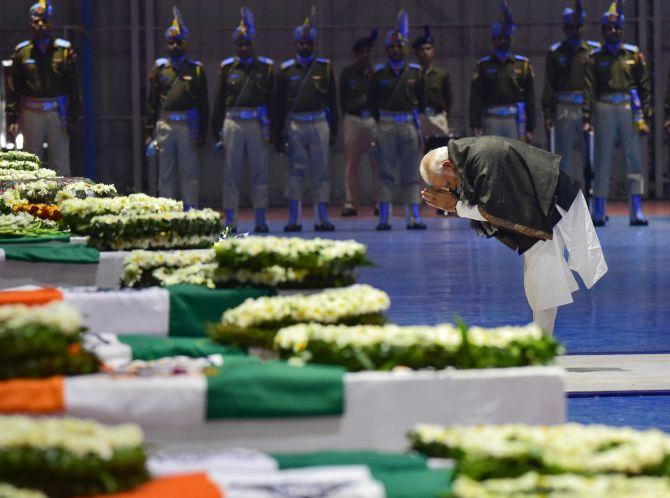
The mood was one of grief and remembrance, and slowly building up into anger and revenge.
'Is India really going to war?' a worried Pakistani journalist friend asked me.
I didn't respond, but an escalating conflict appeared inevitable.
Modi was pretty clear right from the outset: He would not go in for a 'soft' option. 'Previous governments may have chosen the diplomatic route, but this prime minister wanted an offensive option that would end Pakistan's 'nuclear blackmail' once and for all,' says a senior official.
In 2001, when Parliament was attacked, then prime minister Vajpayee had reportedly considered an air strike on Pak-based terror camps but abandoned the idea for fear of the situation spiralling out of control. Instead, a 10-month-long deployment of armed forces along the border under Operation Parakram was the preferred choice.
When terrorists struck in Mumbai in 2008, the Manmohan Singh government too had reportedly weighed the options of an air strike before eventually choosing coercive diplomacy as a more effective response.
'I do not know what the air force was telling itself but that (an air strike) is not the message the political leadership heard from the three chiefs who briefed Dr Singh's government. I heard no fear of escalation, but only a clear calculation of likely outcomes and which would be better for India,' explains Shiv Shankar Menon, former foreign secretary and national security adviser to the UPA government.
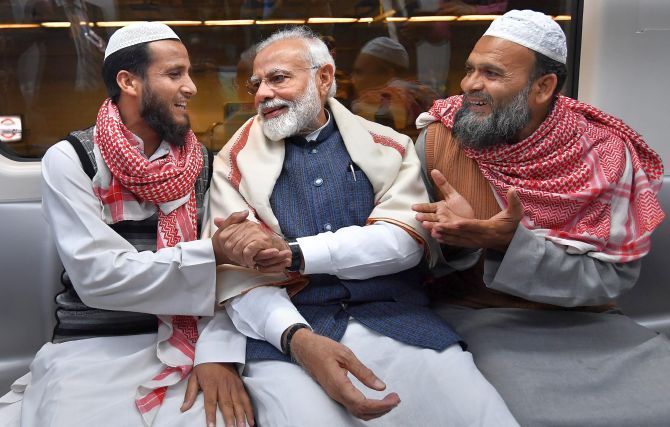
Modi though was unwavering in his belief that the 'strategic restraint' script needed to be rewritten, even if it meant taking an audacious risk before a general election.
The message to Doval and the armed forces chiefs was unambiguous: there must be 'visible' action against the terror groups and their handlers embedded in the Pakistani State.
The focus needed to be on the terror training camps; collateral damage to civilian and military targets was to be avoided at all costs.
In effect, India's response needed to be proportionate to what Pakistan had done and within range of what the international community would view as 'reasonable' action.
The inside story of the air strikes reveals careful planning and a daring yet simple strategy.
Intelligence agencies reportedly chose 15 places run by different terror groups in Pakistan as potential strike targets.
Three specific camps of the Jaish, the organisation widely held responsible for Pulwama, were identified: One was in Bahawalpur in Pakistan's Punjab province, the others in Sawai Nallah near Muzaffarabad in Pak occupied Kashmir and Balakot in the Khyber-Pakhtunkhwa province.
The Bahawalpur complex was ruled out because any strike on it might incur civilian casualties: The complex was located within a fairly densely populated area.
Sawai Nallah was perhaps the easiest to hit since it was closest to the border but any attack in PoK might be seen only as yet another surgical strike.
'Given what had happened in Pulwama, we wanted to make a much bigger noise this time, one that would echo through the country and the world,' admits a government official.
The Jaish camp in Balakot fit all the criteria set by the prime minister: it was located in a relatively isolated area on the crest of a ridge called Jaba Top.
Spread over a sprawling six acres, the camp consisted of ten buildings conducting training activities for terrorists.
The camp was run by Masood Azhar's brother-in-law Yusuf Azhar, who lived in an abandoned school complex on the campus.
It was estimated that over 200 terror recruits were staying in the camp.
A fresh group was to join on February 25, taking the total number to over 300, making it the ideal period to inflict maximum damage.
High-resolution satellite imagery was used to determine the lay of the land.
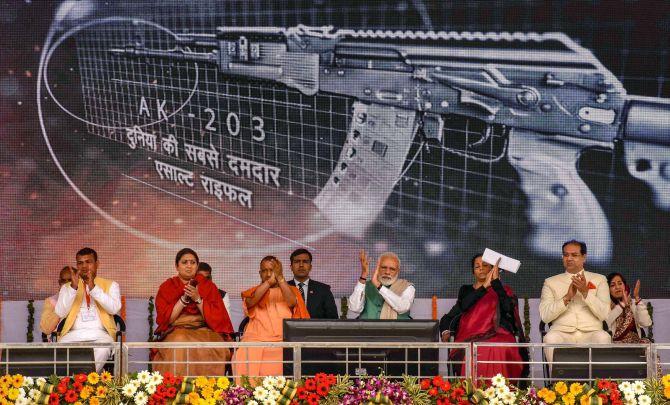
On February 19, Modi gave the go-ahead to the core team led by Doval. The actual strike plan was left to Air Chief Birender Singh Dhanoa to execute.
'We were always ready and waiting for this moment for a very long time,' the fighter pilot chief would later tell journalists.
Operation Bandar was carried out around 3 am on February 26 under the cover of darkness by a squadron of a dozen Mirage 2000 aircraft equipped with Israeli built SPICE (Smart Precise Impact and Cost Effective) bombs and aided by a sophisticated guidance system that could hit with precision at an intended target 60 kilometres away.
The Mirages were accompanied by four Sukhoi 30s to provide air cover. Two surveillance aircraft and two IL 76s were also deployed for mid-air refuelling.
As the aircraft flew into Pakistani airspace, one lot flew towards Bahawalpur, misleading the Pakistan air defence system into believing that the Jaish camp in the Punjab region was the target.
As Pakistani fighters scrambled to take on the Indian jets, the low-flying Mirage 2000s headed for Balakot.
By the time the Pakistani radar detected them, they were already 150 kilometres away.
Five bombs reportedly struck the targets, three of them hitting the buildings where the Jaish recruits were staying.
The actual bombing lasted just 13 minutes, between 3.40 am and 3.53 am; by the early hours of 26 February, the jets were back in India, mission accomplished.
For Modi, the 48 hours leading up to the air strikes had been business as usual.
But under the calm exterior, anxiety was reportedly mounting: Modi would stay awake all night, one eye on the computer screen, the other on the phone.
He had taken a big gamble, one that could make or break his prime ministerial tenure.
It was only around 4 am that Modi was informed of the mission's successful completion and he could finally relax a bit.
His early morning yoga routine was going to be particularly energising.
This was the moment Modi had been waiting for from the day he moved to 7 Lok Kalyan Marg.
His complex persona is riven by a desire to be both feared and embraced.
The 'fear factor' had been established domestically early enough; now, the world was ready to accept him as a true global figure.
Not since the 1971 war, when Indira Gandhi was prime minister, had the Indian Air Force penetrated so deep into Pakistani airspace and inflicted damage on the 'enemy'.
And yet, a few knotty questions remained. Should Balakot really be seen as a 'war-like' triumph?
What of the intelligence failure in Pulwama that had resulted in the loss of 40 jawans?
What of the shooting down of an Indian Mi-17 chopper, allegedly by an IAF missile, in which six servicemen were killed? (The IAF would admit to this 'mistake' only in October 2019 when a new chief took over.)
Should the government not have provided some 'proof' of the 'success' of Operation Bandar?
The last question would prove politically contentious as 'government sources' were busy leaking 'information' that at least 300 terrorists had been killed in Balakot.

While the air force was cautious in putting a figure to the casualties, ministers were calling up journalists to 'confirm' the death toll.
Credible Western media outlets like the New York Times and the Guardian, meanwhile, reported that eyewitness accounts suggested that only a few trees had been felled and there were no signs of mass deaths.
Senior Pakistani TV journalist Hamid Mir, who works for the country's leading news network Geo, put out a video which shows him allegedly in Balakot, claiming that all he has found is a dead crow; the video went viral within hours.
When I contacted Mir and asked him if he was parroting the Pakistani army line, he retorted sharply: 'Why would we not report the story accurately? Weren't we the channel which also broke the story that Ajmal Kasab was a Pakistani after the 26/11 Mumbai terror attack?'
Modi was deservedly basking in his success. A day after Wing Commander Abhinandan Varthaman's release (on March 1, 2019), the prime minister spoke at the annual India Today conclave. He was the last speaker at the two-day summit and a full house was waiting to greet him.
That Modi was on a roll is best illustrated by a story related by ace India Today photographer Bandeep Singh.
Before Modi could walk on to the stage, Singh was doing a quick photo shoot with the prime minister in the waiting room next to the main hall.
'I will need a few more pictures, sir, can I get some time from you for a more extended photo shoot?' asked Singh.
Modi, ever-obliging before the camera, laughed. 'Sure, but let us plan to do it after my swearing-in is over in May!'
The Balakot effect was evident.
Excerpted from 2019: How Modi Won India by Rajdeep Sardesai, with the kind permission of the publishers, HarperCollins India.
